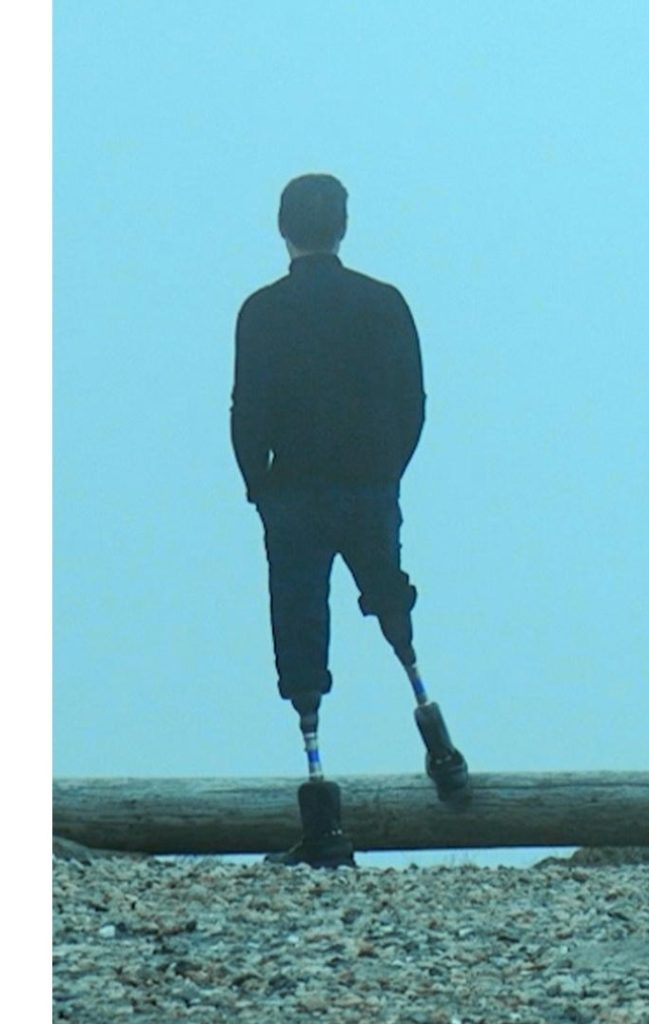
If you haven’t found the time yet to watch “Augmented,” the 84-minute documentary about bioengineering genius Hugh Herr, time’s a-wastin’. You can still access it online at the PBS website, but it’s only available to stream for another week, through March 23. You can see the movie on the PBS website and associated streaming apps.
Originally broadcast in late February on the award-winning series “Nova,” the film traces Herr’s journey from teenage rock-climbing phenom to renowned MIT bioengineer. The title refers to Herr’s belief that the prosthetic limbs of the future won’t merely help people adapt to a loss of capacity; they’ll augment the human body in ways that add capacity above and beyond what nature has provided.
“There’s a very interesting dynamic in how society views the human body, human ability, and human disability,” Herr says in the film. “My legs were amputated, and the whole world says, ‘Oh that’s such a sad story.’ Twelve months post-surgery, I started climbing better than I achieved before my limbs were amputated, climbing wall surfaces that no human had ever climbed before. And then suddenly the narrative changed overnight to” ‘You’re cheating. That’s not fair.'”
Herr, who lost both legs below the knee at age 17, is well known as one of the world’s greatest and most influential innovators in prosthetic technology. We have a better understanding of what makes him tick after watching “Augmented.” Here’s some of what we learned.
As an adolescent, Herr was known in climbing circles as “Hot Hugh.”
“By 10 or 11 years old I was considered a child prodigy,” Herr remembers. “I had national recognition for my climbing prowess. By the time I was 13, climbing is all I ever thought about.” Jeff Batzer, his childhood climbing partner, adds that Herr was known throughout the United States as one of the country’s best climbers of any age.
Herr survived the ordeal that cost him his legs, but a member of the rescue party died.
The incident occurred in 1982, when Herr and Batzer got lost on New Hampshire’s Mount Washington during a rock climbing expedition. Miraculously, they survived four nights in subzero temperatures while dozens of local hikers fanned out across the wilderness trying to find them. One of the would-be rescuers, a man named Albert Dow, was killed in an avalanche while searching in Huntington Ravine, the location where Herr and Batzer were last seen. After Herr was airlifted out of the wilderness with frostbitten feet that couldn’t be saved, he resolved to use the rest of his life to contribute to humanity in memory of Albert Dow’s sacrifice.
He resumed climbing seven months after his amputation.
When Herr received his first pair of prosthetic legs in 1982, they were were so primitive that the sockets were made of plaster of Paris. His prosthetist told him never to walk on the limbs without crutches, lest the plaster crack. The clinician never prohibited rock climbing, however—so Herr and his brother returned to the Pennsylvania cliffs where they’d learned the sport growing up, and Herr taught himself to climb again. “I could barely walk,” he says, “but once I was at the cliff, gripping the rock with fingers and toes, I just felt completely at home.”
The first patient to undergo the innovative amputation surgery devised by Herr and surgeon Matthew Carty was an old rock-climbing buddy of Herr’s.
Jim Ewing met Herr in the mid-1980s, a couple of years after Herr’s bilateral amputation. A self-described “climbing bum,” Ewing used to scale cliffs in a pair of shoes that read “Life sucks” on the left sole, “and then you die” on the right. One day Herr challenged him to justify that dark worldview, Ewing recalls—“and what could I say to a guy who’s sitting there as a bilateral amputee?” In 2014 Ewing shattered his left ankle in a climbing accident, ultimately leading to his own below-knee amputation via Herr and Carty’s method (now called “the Ewing amputation”).
Herr personally tests most of the prototype bionic feet that are designed in his lab at MIT.
“One of the problems we have in research is that the people who are doing the research are not the same people who are affected by the thing that they’re researching,” says Tyler Clites, a research aide who worked on the Ewing procedure. “Hugh breaks that dynamic in a very powerful way.” Another student in Herr’s lab, Matthew Carney, sums up his marching orders this way: “Gimme better legs! We’re at MIT—make me nice legs!”